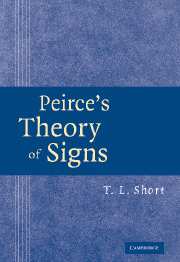Book contents
- Frontmatter
- Contents
- Preface
- Acknowledgments
- 1 Antecedents and Alternatives
- 2 The Development of Peirce's Semeiotic
- 3 Phaneroscopy
- 4 A Preface to Final Causation
- 5 Final Causation
- 6 Significance
- 7 Objects and Interpretants
- 8 A Taxonomy of Signs
- 9 More Taxa
- 10 How Symbols Grow
- 11 Semeiosis and the Mental
- 12 The Structure of Objectivity
- Bibliography
- Name Index
- Subject Index
- Frontmatter
- Contents
- Preface
- Acknowledgments
- 1 Antecedents and Alternatives
- 2 The Development of Peirce's Semeiotic
- 3 Phaneroscopy
- 4 A Preface to Final Causation
- 5 Final Causation
- 6 Significance
- 7 Objects and Interpretants
- 8 A Taxonomy of Signs
- 9 More Taxa
- 10 How Symbols Grow
- 11 Semeiosis and the Mental
- 12 The Structure of Objectivity
- Bibliography
- Name Index
- Subject Index
Summary
Peirce's theory of signs, or semeiotic, misunderstood by so many, has gotten in amongst the wrong crowd. It has been taken up by an interdisciplinary army of ‘semioticians’ whose views and aims are antithetical to Peirce's own, and meanwhile it has been shunned by those philosophers who are working in Peirce's own spirit on the very problems to which his semeiotic was addressed. Those problems are two: to construct a naturalistic but nonreductive account of the human mind, and to explain and defend the claim that the sciences are objective in their mode of inquiry and in fact yield knowledge of an independently existing reality. In the following pages, I attempt to show how contemporary discussions in the philosophies of mind and science might benefit from a deeper study of Peirce's ideas. The purpose of this book is to say what Peirce's theory of signs is and to suggest what its philosophical significance may be.
As to the philosophy of mind: Peirce's mature theory of signs (as opposed to his early theory) is germane to the issues framed by Putnam, Searle, Dretske, Dennett, Fodor, and others. Obviously, a detailed taxonomy of signs, such as Peirce provided, might be of some help to anyone attempting to account for thought as a form of representation. Much more importantly, however, the mature semeiotic was developed in an attempt to explain, on a naturalistic basis, what we (not Peirce) call the ‘intentionality’ of mind.
- Type
- Chapter
- Information
- Peirce's Theory of Signs , pp. ix - xviPublisher: Cambridge University PressPrint publication year: 2007



